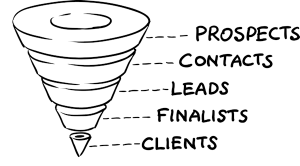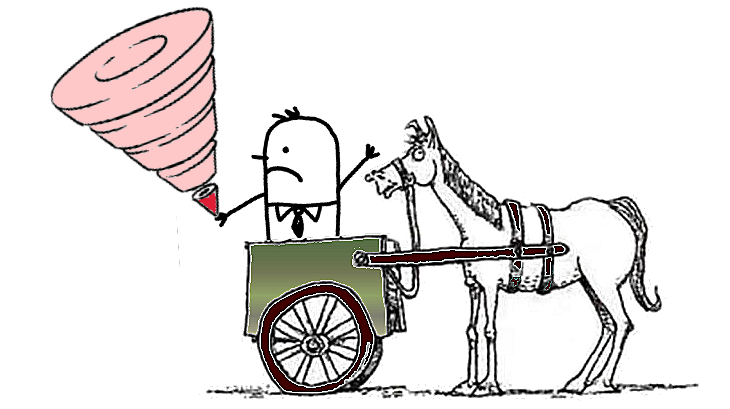 I recently listened to a LinkedIn Webinar on sales funnels and to be honest, the whole idea seemed a bit simplistic. A sales funnel is supposed to turn prospects into customers by attracting mildly interested prospects at the wide end of the funnel and taking them toward the narrow end to seal the deal.
I recently listened to a LinkedIn Webinar on sales funnels and to be honest, the whole idea seemed a bit simplistic. A sales funnel is supposed to turn prospects into customers by attracting mildly interested prospects at the wide end of the funnel and taking them toward the narrow end to seal the deal.
 College recruitment offers a good example of a sales funnel. Students learn about schools from counselors, friends, college fairs and guide books. If curious, they receive direct mailers, and make campus visits. If seriously interested, they go to a recruitment events, receive personal solicitations, and fill out applications. Upon acceptance, they are offered a financial package and, hopefully, select the school. Down, down the funnel they go.
College recruitment offers a good example of a sales funnel. Students learn about schools from counselors, friends, college fairs and guide books. If curious, they receive direct mailers, and make campus visits. If seriously interested, they go to a recruitment events, receive personal solicitations, and fill out applications. Upon acceptance, they are offered a financial package and, hopefully, select the school. Down, down the funnel they go.
A sales funnel is all about process: Where is this prospect in the sales cycle right now – in the wide, middle or narrow end? But the funnel doesn’t account for the actual factors driving the sale: the winning football team, the school ranking, department strength, famous alums, class size, campus perks, parent’s alma mater, peer choices, distance from home, male/female ratio, hipsters versus nerds, cafeteria food, overall prestige, and of course, the financial package.
The brand drives the sales cycle. In the college example above, these “actual factors” constitute the brand. If we put the sales process ahead of the brand drivers, we’re putting the cart before the horse.
 People buy brands, not products. If you’re selling CRM software, you want people to believe that managing a funnel will grow your business. But, if you study successful businesses, you realize that the end-to-end brand experience is driving sales. This explains why ten years ago, people flocked to the Apple iPod Nano for $249 and dismissed the comparable Creative Zen for $99.
People buy brands, not products. If you’re selling CRM software, you want people to believe that managing a funnel will grow your business. But, if you study successful businesses, you realize that the end-to-end brand experience is driving sales. This explains why ten years ago, people flocked to the Apple iPod Nano for $249 and dismissed the comparable Creative Zen for $99.
Brand is how you attract prospects, engage them, pitch to them, close the deal and keep them customers for life.
I’ve swapped my funnel for a brand-driven Sales Engine. A Sales Engine answers these three questions:
- Positioning: Is your brand aligned to your target customer’s needs – the problem they seek to solve? You can’t actually be in business unless you uniquely meet a customer’s need.
- Ecosystem: Have you built a brand experience that leverages sales automation, social media, content marketing, video, interactive, and the whole ecosystem of marketing touchpoints? This is how you pull prospects into the Sales Engine.
- Consistency: Do you deliver a consistent brand message at every point in the sales cycle to attract, engage, pitch and close the deal?
A Sales Engine is visualized as PEP-C: Position, Engage, Pitch, and Close.

- POSITION: Claim a unique position that solves the target customer’s problem.
- ENGAGE: Tell an engaging story on multiple content platforms. Engage prospects with explainer videos, call to action statements, white papers, Webinars, demos, giveaways, self-scheduling and more.
- PITCH: Develop a sales presentation and elevator pitch that speaks to your unique position. Maximize the brand experience with every customer contact, including routine phone calls.
- CLOSE: Craft proposals that deliver the brand experience, not just generic proposals with prices.
Your Sales Engine becomes a road map for building your brand. You might be strong on Engaging but weak on Pitching and Closing. A Sales Engine communicates your unique ability to solve customer needs and makes it effortless for prospects to take each step toward the sale.
Examples of PEP-C tactics:
- “How can we better align our brand to what our prospects are seeking?”
- “Let’s write a white paper that positions our company as the industry thought leader, then drive people to read it via social media.”
- “Let’s dump our proposal and hire a designer to develop a graphically-driven proposal template.”
- “How can we use video to tell our brand story in more places?”
Sales Engines are perpetual works in progress. There may be no end to the development process, but at every step of development, your Sales Engine will deliver exponentially by strengthening your brand.
To learn how to build a Sales Engine, read this article. Feel free to contact me with questions and comments.
—
Bruce Miller is a brand strategist who specializes in hands-on brand-building for start-up launches and small to medium size businesses. He has particular expertise in healthcare, technology, and the franchise industry. After a 20 year career in corporate marketing and as a partner in an Atlanta-based creative agency, Bruce now works as a freelance consultant as Miller eMedia.

